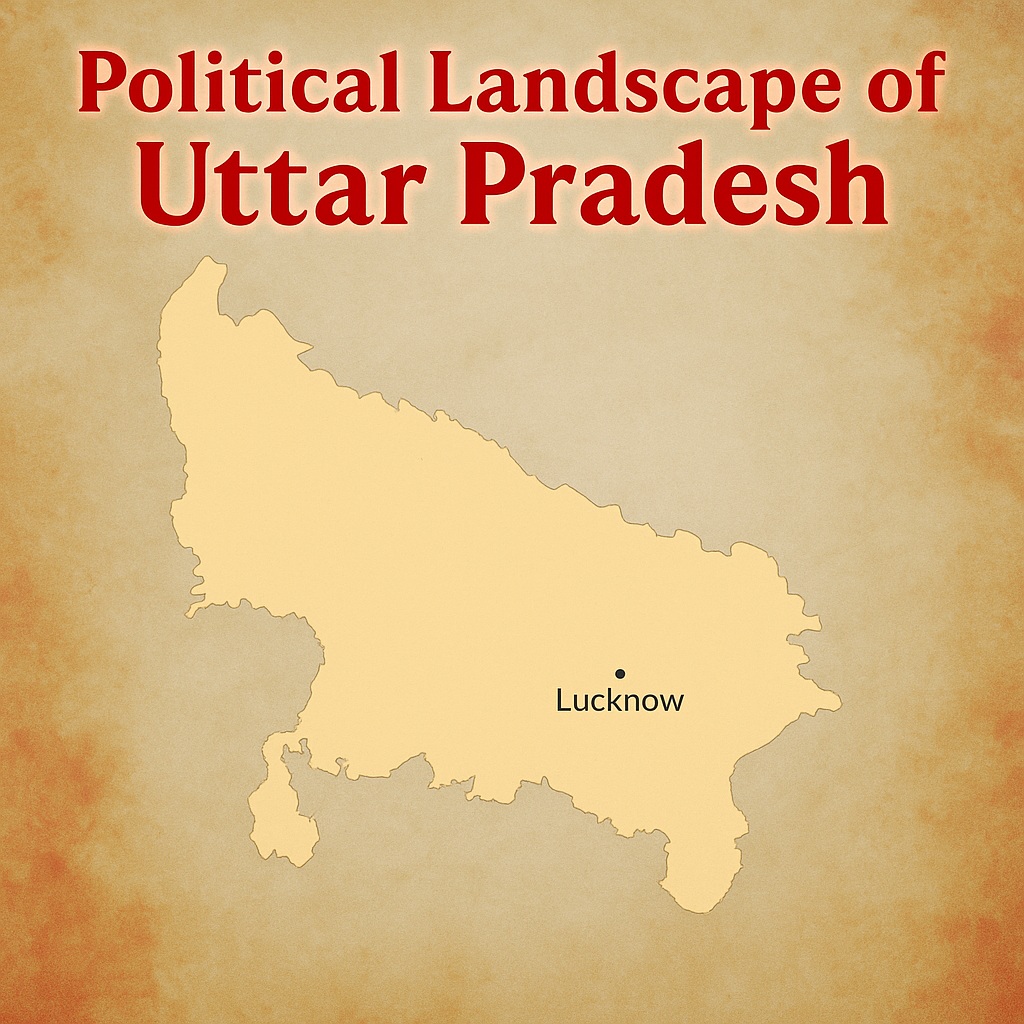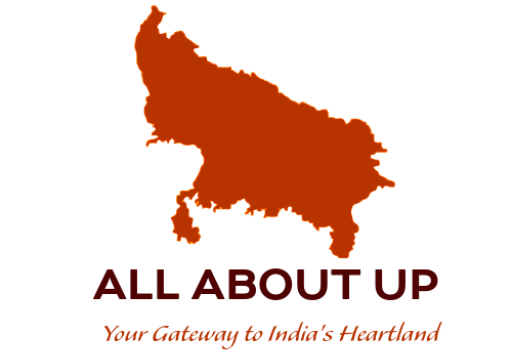
The Political Landscape of Uttar Pradesh: A Historical and Contemporary Overview
Uttar Pradesh (UP), India’s most populous state, has remained a pivotal force in Indian politics. With 80 Lok Sabha seats, the state often dictates the political narrative at the national level. The political landscape of Uttar Pradesh is marked by evolving ideologies, deep-rooted caste equations, shifting party loyalties, and the interdependence of state and union politics. This article traces the political evolution of UP through different phases, exploring its influence on national politics, the imposition of President’s Rule, and its current dynamics.
Pre-Independence and Early Post-Independence Period (1937–1967)
The roots of political activity in UP go back to the British era, when it was known as the United Provinces. The Indian National Congress (INC) was the dominant political force during this period. The 1937 provincial elections, held under the Government of India Act 1935, saw the Congress forming the government in the province.
After Independence, the state was renamed Uttar Pradesh in 1950. From 1952 to 1967, the Congress maintained an unchallenged dominance, producing key national leaders like Jawaharlal Nehru, Lal Bahadur Shastri, and Govind Ballabh Pant. The state’s politics revolved around the Congress party, which commanded significant support from all castes and communities.
Decline of Congress and Rise of Regionalism (1967–1989)
The 1967 Assembly elections marked a turning point. For the first time, Congress lost its majority in the state assembly, and a coalition of opposition parties formed the government under the banner of the Samyukta Vidhayak Dal (SVD). This period saw frequent changes in leadership, political instability, and the emergence of regional leaders.
Caste and community identities began shaping political allegiances. The backward classes, Dalits, and minorities started seeking political representation through regional outfits. Charan Singh’s Bharatiya Kranti Dal, later merged into the Janata Party, gained traction, especially among the agrarian Jat community in western UP.
Mandal, Mandir, and Polarization (1990s)
Political Landscape of Uttar Pradesh: The 1990s witnessed a significant transformation in UP’s political landscape. The implementation of the Mandal Commission report by the VP Singh government in 1990 led to a new era of OBC assertion. In UP, this translated into the rise of the Samajwadi Party (SP) led by Mulayam Singh Yadav and the Bahujan Samaj Party (BSP) founded by Kanshi Ram and later led by Mayawati, representing Dalits.
Simultaneously, the Ram Janmabhoomi movement spearheaded by the Bharatiya Janata Party (BJP) transformed Hindu religious identity into a powerful political force. The demolition of the Babri Masjid in 1992 polarised the electorate, allowing the BJP to consolidate its Hindu support base.
During this decade, UP saw multiple coalition governments, unstable alliances, and frequent imposition of President’s Rule.
The Coalition Era and Alternating Power (1993–2012)
Political Landscape of Uttar Pradesh: The post-Babri phase saw the SP and BSP emerging as the two dominant regional parties, often alternating in power. The BJP retained a strong presence but rarely achieved a full majority. The SP and BSP formed and broke alliances with both each other and national parties depending on political convenience.
In 1995, Mayawati became the first Dalit woman Chief Minister of any Indian state with BJP’s support. Her tenure, though brief, marked the rise of identity politics. The SP under Mulayam Singh focused on consolidating the OBC-Muslim-Yadav vote bank. This period saw volatile politics, frequent elections, and policy shifts.
From 2007 to 2012, Mayawati led a full-term BSP government with a clear majority. She attempted a ‘social engineering’ model by bringing together Brahmins and Dalits, but this alliance weakened over time.
The BJP Resurgence and Modi Wave (2014–Present)
Political Landscape of Uttar Pradesh: The 2014 Lok Sabha elections brought a sweeping victory for the BJP in Uttar Pradesh. Riding on the ‘Modi wave’, the party won 71 out of 80 seats. This trend continued in the 2017 Assembly elections where the BJP secured over 300 seats out of 403.
Yogi Adityanath was appointed Chief Minister, marking a shift towards hardline Hindutva politics combined with promises of development, law and order, and welfare schemes. The 2019 Lok Sabha elections further consolidated BJP’s dominance, with the party again winning 62 seats despite the SP-BSP alliance.
In the 2022 Assembly elections, BJP retained power in UP, making Yogi Adityanath the first CM in decades to return to office after completing a full term.
Union Politics and Its Impact on Uttar Pradesh
Political Landscape of Uttar Pradesh: Union politics has deeply influenced state politics in Uttar Pradesh. Being home to several prime ministers, including Jawaharlal Nehru, Indira Gandhi, Rajiv Gandhi, VP Singh, Atal Bihari Vajpayee, and Narendra Modi (though elected from Varanasi), UP has always been at the center of national attention.
National-level political trends often reflect in the state’s voting patterns. When the Congress was strong nationally, it dominated UP. The rise of BJP at the center has mirrored its growth in the state. Welfare schemes like Ujjwala Yojana, Ayushman Bharat, and free ration distribution under the PM Garib Kalyan Yojana have influenced state-level electoral outcomes.
Moreover, the selection of Yogi Adityanath—a religious figure and MP from Gorakhpur—as CM was a strategic move by the BJP to blend governance with cultural nationalism, a theme that resonates both in UP and at the national level.
President’s Rule in Uttar Pradesh
Uttar Pradesh has witnessed President’s Rule on nine occasions since Independence. These were:
- 1968 – Following instability after Charan Singh’s government fell.
- 1970 – After the collapse of Tribhuvan Narain Singh’s government.
- 1973 – Due to political defection and loss of majority.
- 1975 – During the Emergency period.
- 1977 – Post-Emergency elections.
- 1980 – After the Janata Party split.
- 1992 – Following the Babri Masjid demolition.
- 1996 – Due to hung assembly and delay in government formation.
- 2002 – Due to political uncertainty after assembly elections.
These instances highlight the chronic political instability in the state, particularly during coalition eras.
Uttar Pradesh’s Impact on National Politics
Political Landscape of Uttar Pradesh: Uttar Pradesh has consistently shaped the course of Indian national politics. With 80 Lok Sabha seats—the highest for any state—it holds significant sway in determining the composition of the central government. Historically, UP has produced the largest number of prime ministers, including Jawaharlal Nehru, Indira Gandhi, Atal Bihari Vajpayee, and Narendra Modi (elected from Varanasi). The state often serves as a political laboratory, where strategies on caste coalitions, communal narratives, and welfare schemes are tested before being scaled nationally. Movements like the Ram Janmabhoomi campaign and Mandal politics originated in UP before reshaping union-level discourse. Regional parties like the SP and BSP, though rooted in state politics, have played kingmakers in coalition governments at the Centre.
Thus, UP’s polity doesn’t just reflect national trends—it actively drives them, making the state an indispensable player in India’s democratic evolution.
Presidents from Uttar Pradesh
- Dr. Rajendra Prasad (Actively associated with UP though born in Bihar)
- Born: Ziradei, Bihar
- Education (in UP): Studied at Allahabad University
- Office: 1st President of India (1950–1962)
- Note: Though from Bihar, he was politically and educationally active in UP, especially during the freedom struggle.
- Dr. Zakir Husain
- Born: Hyderabad (Telangana), but spent most of his life in UP
- Associated City: Aligarh (Co-founder of Jamia Millia Islamia), later moved to Delhi
- Education: Aligarh Muslim University
- Office: 3rd President of India (1967–1969)
- Note: He was the first Muslim President of India and died in office.
- Fakhruddin Ali Ahmed
- Born: Delhi, but family roots in UP (Gonda district)
- Education: Delhi and England (St. Catharine’s College, Cambridge)
- Office: 5th President of India (1974–1977)
- Ram Nath Kovind
- Born: Paraunkh, Kanpur Dehat, Uttar Pradesh
- Education: DAV College (Kanpur), Law degree from Kanpur University
- Office: 14th President of India (2017–2022)
Prime Ministers from Uttar Pradesh
- Jawaharlal Nehru
- Born: Allahabad (now Prayagraj), Uttar Pradesh
- Education: Harrow School & Trinity College, Cambridge; Law at Inner Temple, London
- Office: 1st Prime Minister of India (1947–1964)
- Note: Longest-serving Prime Minister; central figure in Indian independence and post-independence politics.
- Lal Bahadur Shastri
- Born: Mughalsarai (now Pt. Deen Dayal Upadhyaya Nagar), Uttar Pradesh
- Education: Kashi Vidyapeeth, Varanasi
- Office: 2nd Prime Minister (1964–1966)
- Note: Known for his slogan “Jai Jawan Jai Kisan”; died in Tashkent under mysterious circumstances.
- Indira Gandhi
- Born: Allahabad (now Prayagraj), Uttar Pradesh
- Education: Visva-Bharati University (Santiniketan), Oxford University (UK)
- Office: 3rd Prime Minister (1966–1977, 1980–1984)
- Note: First and only female PM; known for Emergency (1975–77), 1971 war victory.
- Charan Singh
- Born: Noorpur, Hapur district, Uttar Pradesh
- Education: Agra University (Law)
- Office: 5th Prime Minister (1979–1980)
- Note: Known for agrarian reforms and farmers’ rights; had a brief tenure.
- Vishwanath Pratap Singh (V. P. Singh)
- Born: Allahabad (now Prayagraj), Uttar Pradesh
- Education: Allahabad University, University of Pune
- Office: 7th Prime Minister (1989–1990)
- Note: Implemented Mandal Commission; known for social justice politics.
- Atal Bihari Vajpayee
- Born: Gwalior, Madhya Pradesh (but politically from Lucknow, UP)
- Education: DAV College, Kanpur
- Office: 10th Prime Minister (1996; 1998–2004)
- Note: Served from Lucknow constituency; known for liberal nationalism and infrastructure growth.
- Narendra Modi(by constituency, not by birth)
- Born: Vadnagar, Gujarat
- UP Connection: Elected from Varanasi since 2014
- Education: Gujarat University; correspondence course from Delhi University
- Office: 14th Prime Minister (2014–Present)
- Note: Represents UP in Parliament; has heavily invested political capital in the state.
Conclusion: The Road Ahead
Political Landscape of Uttar Pradesh: Uttar Pradesh continues to be a politically crucial state for any party aspiring to rule at the Centre. The state’s voters have grown increasingly responsive to narratives of governance, development, and identity. With younger voters, growing urbanization, and shifting caste alignments, UP’s political future remains dynamic.
The rise of the BJP has reshaped the political discourse, but the SP, BSP, and Congress still hold influence in select regions. The interplay between national leadership and local aspirations will continue to define the political direction of Uttar Pradesh in the coming decades.
While the past has been turbulent, the future of UP politics depends on how effectively leaders address the state’s social diversity, economic needs, and governance challenges while balancing the impact of national politics on the regional canvas.
